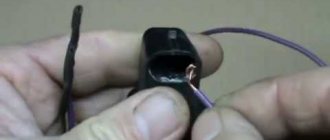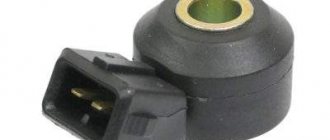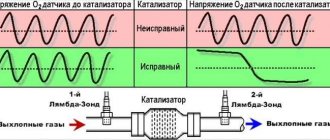Modern car owners independently diagnose certain errors in the car's ECU. The scanner allows you to quickly and accurately identify any problems in systems and indicate further actions to eliminate them.
IMPORTANT! When checking independently with an auto scanner, a driver who encounters error p0130 does not have to contact the service center, but can fix the problem with his own hands. In the overwhelming majority of cases, the causes of this error do not require professional instruments and specialized equipment for repair.
Causes of error P0130
The most common causes of this error are:
- Disconnecting the oxygen sensor connector
- Corroded oxygen sensor connector
- Damage to the electrical wires coming from the oxygen sensor to the ECM
- Fuel supply limitation (fuel pump malfunction or fuel filter clogged)
- Air intake system leakage
- Air or fuel system leakage
- Malfunction of the mass air flow sensor
- Malfunction of the absolute pressure sensor in the intake manifold
- Malfunction in the fuel vapor recovery system
- Oxygen sensor malfunction
- Fuel pressure regulator malfunction
- Engine control module (ECM) malfunction
How does a mechanic diagnose a P0130 code?
To properly diagnose the P0130 code, you will need an advanced diagnostic scanner that can not only read stored trouble codes, but also view readings from various sensors in real time.
First, the mechanic reads all the stored data and error codes using an OBD-II scanner to find out when and under what circumstances the P0130 code appeared. He will then clear the error codes from the computer's memory and test drive the vehicle to see if the P0130 code appears again.
If the error code appears again, the mechanic will continue diagnosing to determine the cause of the error. To do this he will need:
- Advanced diagnostic scanner
- Digital voltmeter
- Smoke installation for detecting leaks in the intake system
Common mistakes when diagnosing code P0130
The most common mistake when diagnosing a P0130 code is to rush to replace the oxygen sensor without first checking it.
Before replacing the sensor, it is necessary to perform a thorough diagnosis using special equipment and consider all possible causes of the error.
Since there can be multiple causes for the P0130 code, replacing the sensor may not solve the problem and may cause the code to reappear.
Lambda probe on VAZ cars
VAZs use several types of sensors:
1. Bosch No. 0 258 005 133, Euro standard - 2. Installed on outdated models with an engine capacity of 1.5 liters. On later models with Euro 3 standard, this sensor was used as the first one, and was installed before the catalyst.
The second sensor was installed, which has a “return connector”. But you can find two identical sensors installed
2. Bosch No. 0 258 006537 was installed on cars manufactured since October 2004. They have a heating element in their structure.
Lambda probes produced are interchangeable with zirconium sensors of similar structure. Please note that a non-heated sensor can be replaced with a heated sensor. Not the other way around.
What repairs can fix the P0130 code?
To resolve P0130, you may need to:
- Connecting the OBD-II scanner to the vehicle diagnostic connector
- Checking for an Error Code
- Analysis of data stored in the vehicle's ECM memory
- Clearing error codes from computer memory
- Test drive your vehicle to see if P0130 appears again
- Check and, if necessary, repair or replace electrical wires or oxygen sensor connector
- Checking and, if necessary, replacing the oxygen sensor
- Check and, if necessary, replace the engine control module (ECM)
Oxygen sensor. How scary is a lambda failure?
About 15 years ago, a lambda probe was a horror story worse than an “automatic” in the first years of our acquaintance with foreign cars. The sudden increase in fuel consumption, without studying the reasons, was blamed on it with almost no options. They showed the owner some “numbers” on the screen, said “oxygen” and confronted him with a fact - it needs to be changed. On the other hand, additives in gasoline then actually quickly disabled lambdas. How are things going with this now? What, besides fuel, can the sensor indicate, how to check it and what to change it to?
More accurate with it than without it
As we recently told you, MAF and MAP are the first and main tools from whose readings the engine control unit is based, preparing the air-fuel mixture. For some time they made do with only them. But it soon became clear that calculating the amount of fuel that needs to be supplied based only on the air entering the engine is not entirely accurate. Allegedly, Bosch, which bought a license from the Americans for the Bendix Electrojector injection system, was already working on an oxygen sensor in the 60s (the German D-Jetronic appeared in 1967). True, this appeared only in 1976 - as part of the K-Jetronic mechanical injection. It is believed that the first cars to receive oxygen were the Volvo 260 series and the famous DeLorean.
At the same time, Bosch continued to produce a mechanical system without lambda. In the 80s, the company also had electronic injection, without an oxygen sensor. However, by that time it had already become clear that with feedback the control unit more accurately operates the fuel supply. It was just not always necessary for economic and environmental reasons. However, since the beginning of that decade, Bosch has been launching the LU1- and LU2-Jetronic, which have lambda regulation. And by the end of the 80s, the lambda probe became widespread. Moreover, at the same time, on certain models intended for markets with the most stringent economic standards, a heating element appeared in the sensor, designed to bring it to operating mode as quickly as possible. Let's look at the design of the “oxygen tank”.
Accuracy is a relative concept
A lambda probe is actually two electrodes separated by a solid electrolyte in the form of zirconium dioxide ceramic. Rarely - from titanium dioxide.
The external electrode (hidden under a protective cap with slots) is located in the exhaust gas flow.
The internal electrode is located in air under atmospheric pressure. Air gets inside or through the place where the wiring enters the sensor, ...
...or through special holes covered with some porous material.
Two electrodes with an electrolyte between them form a galvanic cell. But zirconium dioxide becomes conductive only when heated to more than 300 degrees. In other words, immediately after starting the lambda probe does not work. The exhaust is “dirtier” than when the oxygen system reaches operating mode. It is for this purpose that a heating element was added to the sensor, which brings it to the desired temperature much faster than exhaust gases. Such sensors are distinguished by three or four wires instead of one or two.
When the probe is operating, if there is oxygen only on the internal electrode, the sensor generates the corresponding voltage, which is seen by the control unit. The ECU understands this as a “rich mixture” and adjusts the fuel supply. If oxygen appears in the exhaust gases, the voltage supplied from the sensor drops. For the ECU, this is a signal that the mixture is lean. Of course, communication does not follow the “on/off” principle. For example, the “oxygen man” sees a stoichiometric (ideal, with a ratio of 14.7:1) mixture. And yet, the lambda probe assesses the presence of oxygen quite roughly - whether it is there or not. The correction occurs in a small range, in terms of voltage - only in the range from 0 to 1 volt. But he is unable to determine the composition of the exhaust gases, that is, how much the mixture differs from the stoichiometric one.
Therefore, back in the early 90s, NTK (a sub-brand of NGK) proposed a so-called broadband lambda probe, or mixture composition sensor. From the outside, it resembles a regular lambda. But it has a different design.
It has two cells inside - measuring and pumping. Even with simple stoichiometric mixture sensors, a voltage of 0.45 V corresponds. If it changes, the pump cell supplies or pumps out a certain amount of air into the measuring chamber or pumps it out from there. And by changing the current required for this, the control unit sees the composition of the mixture and adjusts the fuel supply.
The measurement range is up to 5 V. Naturally, a heating element is used. And the connection with the ECU consists of five or six wires. Since the late 90s (Euro 3 standards), a wideband sensor has become an integral attribute of upper-middle class cars. And from the early to mid-2000s, closer to the advent of Euro-4 or already with these environmental requirements, mixture composition sensors replaced conventional lambda probes. At the same time or a little earlier, a second sensor appeared behind the catalyst, moved close to the exhaust manifold.
First of all, he evaluates the condition of the neutralizer - what is its flow capacity, that is, has it melted or not. The “Lambda” behind the converter is simple. However, it is believed that, at least in some cases, it can also influence the preparation of the air-fuel mixture ECU. The chances of this second oxygen sensor being damaged in any way are less than the first. Still, it is located behind the catalyst and takes on already purified exhaust gases. Although there are certain operating rules regarding it. Well, the first “oxygen” is even more at risk. So what can both suffer from?
The resource is great, but there are nuances
The main enemy of the oxygen sensor has always been fuel additives - primarily octane-boosting and anti-knock additives. And tetraethyl lead, which has not been used for a long time. And especially those containing iron, which covered it with a conductive coating, which is why the lambda was “confused in the readings” if it did not fail at all.
Nowadays, ferrocene additives are used only to a limited extent. Although you can certainly run into them somewhere in the provinces. However, many compounds added to the fuel can contaminate the external electrode, rendering the oxygen tank inoperable. A decent (say, from several hundred grams per 1000 km) oil consumption for waste is also able to do this. Finally, sensors have a certain resource. True, according to widespread information, it lies within a very wide range - from 40,000 to more than 100,000 km.
Symptoms of sensor loss may vary. What unites almost all systems is that, most likely, the check engine will light up. But this is not a mandatory condition either. Fuel consumption increases, but not always so much that the owner will definitely notice it. If fuel overflows from the exhaust pipe, it may smell like gasoline. In addition, the engine can fail at idle and have traction failures during acceleration. Just stall.
But this concerns the failure of the main working element itself - the galvanic element. But it happens that the sensor’s heating module—essentially a plate or spiral, like a kettle-boiler—fails. Because of which? You can't blame gasoline or oil here. Natural aging remains. Moreover, the heater is capable of psychologically stressing the owner - the check will light up if it fails. But it is unlikely that you will be able to feel any changes, at least not within the limits of a change in season or driving style. Of course, being without warming up, for some time after starting the lambda does not send a signal to the control unit. And theoretically, at this moment the engine should consume more fuel. In reality, its overspending may turn out to be so insignificant that the owner will not notice it. However, let's listen to the diagnosticians.
Roman Evdokimov
Head of STO "AutoMozg"
— Theoretically, any impurities in gasoline can damage the lambda probe. Moreover, motor oil, which, if the waste consumption is high, ends up in a burnt form on its outer electrode. I won’t tell you the exact meaning of the latter. I will only note that now we are not seeing widespread refusals.
The consequences of failure can be extremely varied. Some people won’t even notice changes in fuel consumption, which greatly depends on the outside temperature. By the way, it may even decrease somewhat - such cases are known. On certain models - for example, modern Mercedes-Benz - if any error occurs, an emergency mode with traction limitation is activated. And the “oxygen generator” is no exception here, even if only its heating element has failed. Some Hondas of the 2000s, surprisingly, also initiate an “accident” - just because the second lambda is not working.
Without a working sensor in front of the catalyst, the control unit will incorrectly prepare the air-fuel mixture, overfill or lean. In the first case, excess fuel will burn out in the catalyst. If the mixture is lean, there will be no flash in the combustion chambers and unburned gasoline will again go to the converter. Needless to say, what will eventually happen to him.
Previously, not all scanners saw lambda readings. We checked it mainly with an oscilloscope, which can still give a more complete picture of its performance. But now there is no urgent need to use this device. At least in some cases, even the diagnostic block and the corresponding program on the phone allow you to see the operation of the sensor.
Buying a universal sensor is a lottery. Yes, they are cheaper than the original ones. But there is no guarantee that they will work. In any case, we know of examples where the pinout in the connectors did not match the one on the car. This can be solved. What’s worse is that the system may simply not see the universal “lambda”. At the same time, sellers, as a rule, do not accept them back - they see that they have already been installed by the flattened sealing washer. An alternative to original ones, at least for older and inexpensive cars, is to buy used ones. Such people can often work for quite a long time.
Another point of view, mainly on the “Japanese” of different years of production.
Andrey Galichin
Automotive diagnostician
— Both conventional lambda probes and mixture composition sensors, that is, broadband ones, are checked simply. An oscilloscope is, of course, an accurate and reliable diagnostic tool. But a competent technician will see the status of the sensor based on the values on the scanner. Moreover, it is unprincipled that the “lambda” does not work at all or gives not entirely correct information and is slow. All the same, the mixture formation is going wrong.
The heating element of the sensor fails not only from old age, although this is the most common reason. Maybe from mechanical impact. A colleague was repairing the suspension of his own car, hit the exhaust tract near the sensor with a hammer and apparently shook it off. He did not stop evaluating the mixture, but lost heat. At subzero temperatures, due to the lack of heating, you can actually feel the increased fuel consumption. Not only during low-temperature starts, but, for example, in city traffic jams, when the exhaust manifold can be cooled below 300℃.
Another example of a likely possibility of condemning the sensor is to wade. Dive deep enough to fill the first lambda. On older cars, the catalyst may be located quite low, and the sensor may be located directly in front of it.
The second “oxygen”, which controls the catalyst and is also always heated, is located below, and you can “wet” it even in a deep puddle. A sudden change in temperature will damage the heating.
At the same time, I would not say that customers are rushing to replace lambda probes. I also didn’t come across sensors in a “coat” of soot. In general, there are a lot of resources. For example, according to Toyota manuals, they need to be checked at 100,000 km and only replaced if necessary. On my Harrier with 5S, the lambda lasted 230,000 km.
But it is impossible to ignore a sensor malfunction - it leads to disruptions in the operation of the engine control system. On the “Japanese” cars of the 90s, the engine could easily stall. It worked intermittently, with failures during overclocking. True, some cars do not react in any way to a problematic lambda.
On newer models, and especially modern ones, the system can easily fail. Sometimes without “seeing” the readings from the second lambda probe. In this situation, you need to look at the catalyst. If the first sensor fails, be sure to replace it! The CPG will not be damaged by fuel overflow for this reason. But the neutralizer itself will very likely melt.
It’s not worth buying “oxygen tanks” from little-known brands. Although the original ones used to work for just a week or two. In general, I recommend Bosch, Denso, NGK. Universal ones are usually sold without a “chip”. Bosch has a connector, but not always either. We use NGK/NTK and have never encountered any failures due to poor quality.
But here is an opinion from the “competing camp” - from the structure involved in servicing and repairing the “Germans”:
Alexander Sannikov
Director of development of service station Das Autoservice
— The lambda probe is a pretty durable thing. Of course, both scorched gasoline and the oil-guzzler can finish her off. Another thing is that the first one is already a rarity in more or less large cities. And secondly, if it reaches half a liter per 1000 km, then the car owner is unlikely to be bothered by some kind of sensor. Often the “oxygen generators” (especially the second “lambda”) are located quite low and are constantly exposed to dirt and moisture. And they still work! Resource? For example, Bosch claims that its sensors will operate for at least 150,000 km. We generally confirm this, with the exception of rare cases.
The heating element of lambda probes is just as resourceful and, as a rule, fails only due to natural wear and tear. However, it happens that it is damaged mechanically - for example, by road stones or from natural vibrations during dismantling and installation of the exhaust. In fact, this does not lead to any consequences - the Check light will light up, and lambda regulation of the air-fuel mixture composition or lambda monitoring of exhaust cleanliness will turn on later, as the probe warms up naturally from the exhaust gases. Failure of the heating of the second lambda probe behind the catalyst will not lead to anything other than an indicator on the instrument panel, but if we are talking about the first lambda, then the exhaust will become a little dirtier in the first minutes and fuel consumption will increase by a fraction. For the owner, the first will not be important, and he most likely will not notice the second.
But it is difficult not to pay attention to the malfunction of the lambda probe itself. The car will either stall or run unevenly and smell of unburnt gasoline coming from the exhaust pipe. Also, the engine may stall, stall, or fail to develop power. For German cars with their precision engines, even a Check Engine light that comes on without any additional symptoms is already a reason to go for diagnostics. And here it is! However, there is no need to worry about the CPG. However, if you ignore this (it is quite possible that the car will somehow move), sooner or later the catalyst will be destroyed - it will melt.
We install Bosch repair sensors on clients' cars. All “Germans” are equipped with lambda probes from this manufacturer on the assembly line, and the repair kit differs from the original only in slightly greater versatility - the length of the wires and the compatibility of the connectors. At the same time, we periodically observe how in other services, when changing sensors for V6, V8, V10 and V12, they confuse the right and left sides - unstable engine operation at idle and loss of power while driving in this case are guaranteed.
We would like to add that on V-type or boxer engines, if the sensor on one side of the block malfunctions (no matter whether it was caused by refueling with low-quality fuel or the resource has reached the end of its life), you should soon expect the second one to “end” as well. And they need to be changed in pairs - to eliminate the possibility of asynchronous operation.
Let's also say that for the first and second “lambda” there are not always analogues from Bosch, Denso, Delphi, NGK. And even from manufacturers from China. The latter is probably for the best. But the lack of an alternative from actual assembly line suppliers forces you to buy parts under the brands of automakers. And this is much more expensive.
| Name/Model | Toyota Harrier U10, 1MZ (1997–2003) | Toyota Corolla E140, 1NZ (2006–2012) | Mitsubishi Outlander GF0W, 4B12 (2012 - present) | Skoda Octavia A7, 1.8 TSI (2012–2020) |
| Mixture composition sensor (1st “lambda”), original/alternative | 12 000/4500–5400 | 11 200/4300–11 500 | 2000/3900 | 17 700/8400 |
| Oxygen sensor (2nd “lambda”), original/alternative | 9300/1900–3900 | 8800 | 3200/1900–9500 | 4400/1900–2800 |









